Related Research Articles

The Visayas, or the Visayan Islands, are one of the three principal geographical divisions of the Philippines, along with Luzon and Mindanao. Located in the central part of the archipelago, it consists of several islands, primarily surrounding the Visayan Sea, although the Visayas are also considered the northeast extremity of the entire Sulu Sea. Its inhabitants are predominantly the Visayan peoples.

Bohol, officially the Province of Bohol, is an island province of the Philippines located in the Central Visayas region, consisting of the island itself and 75 minor surrounding islands. Its capital is Tagbilaran. With a land area of 4,821 km2 (1,861 sq mi) and a coastline 261 km (162 mi) long, Bohol is the tenth largest island of the Philippines.
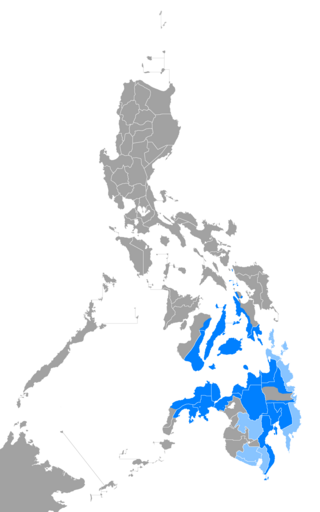
Cebuano is an Austronesian language spoken in the southern Philippines. It is natively, though informally, called by its generic term Bisayâ or Binisayâ and sometimes referred to in English sources as Cebuan. It is spoken by the Visayan ethnolinguistic groups native to the islands of Cebu, Bohol, Siquijor, the eastern half of Negros, the western half of Leyte, and the northern coastal areas of Northern Mindanao and the eastern part of Zamboanga del Norte due to Spanish settlements during 18th century. In modern times, it has also spread to the Davao Region, Cotabato, Camiguin, parts of the Dinagat Islands, and the lowland regions of Caraga, often displacing native languages in those areas.
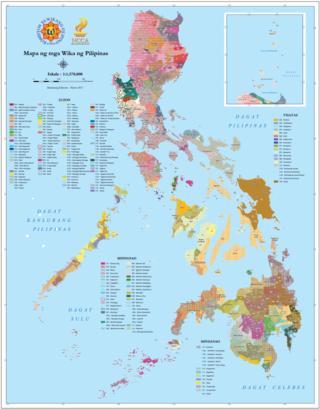
There are some 130 to 195 languages spoken in the Philippines, depending on the method of classification. Almost all are Malayo-Polynesian languages native to the archipelago. A number of Spanish-influenced creole varieties generally called Chavacano along with some local varieties of Chinese are also spoken in certain communities. The 1987 constitution designates Filipino, a standardized version of Tagalog, as the national language and an official language along with English. Filipino is regulated by Commission on the Filipino Language and serves as a lingua franca used by Filipinos of various ethnolinguistic backgrounds.

The Bisayan languages or Visayan languages are a subgroup of the Austronesian languages spoken in the Philippines. They are most closely related to Tagalog and the Bikol languages, all of which are part of the Central Philippine languages. Most Bisayan languages are spoken in the whole Visayas section of the country, but they are also spoken in the southern part of the Bicol Region, islands south of Luzon, such as those that make up Romblon, most of the areas of Mindanao and the province of Sulu located southwest of Mindanao. Some residents of Metro Manila also speak one of the Bisayan languages.
The Central Philippine languages are the most geographically widespread demonstrated group of languages in the Philippines, being spoken in southern Luzon, Visayas, Mindanao, and Sulu. They are also the most populous, including Tagalog, Bikol, and the major Visayan languages Cebuano, Hiligaynon, Waray, Kinaray-a, and Tausug, with some forty languages all together.

Surigaonon is an Austronesian language spoken by Surigaonon people. As a regional Philippine language, it is spoken in the province of Surigao del Norte, Dinagat Islands, Surigao del Sur, and some portions of Agusan del Norte, especially the towns near Lake Mainit, Agusan del Sur and Davao Oriental.

Moalboal, officially the Municipality of Moalboal, is a 1st class municipality in the province of Cebu, Philippines. According to the 2020 census, it has a population of 36,930.

Bien Unido, officially the Municipality of Bien Unido, is a 4th class municipality in the province of Bohol, Philippines. According to the 2020 census, it has a population of 26,666 people.

Opol, officially the Municipality of Opol, is a 2nd class municipality in the province of Misamis Oriental, Philippines. According to the 2020 census, it has a population of 66,327 people.
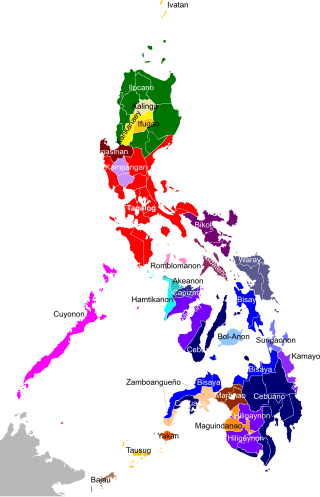
The Philippines is inhabited by more than 182 ethnolinguistic groups, many of which are classified as "Indigenous Peoples" under the country's Indigenous Peoples' Rights Act of 1997. Traditionally-Muslim peoples from the southernmost island group of Mindanao are usually categorized together as Moro peoples, whether they are classified as Indigenous peoples or not. About 142 are classified as non-Muslim Indigenous people groups, and about 19 ethnolinguistic groups are classified as neither Indigenous nor Moro. Various migrant groups have also had a significant presence throughout the country's history.
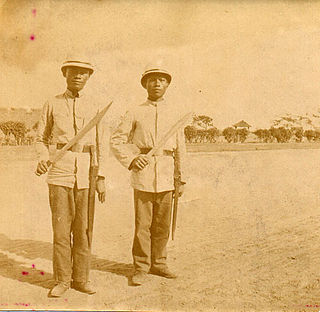
The Cebuano people are the largest subgroup of the larger ethnolinguistic group Visayans, who constitute the largest Filipino ethnolinguistic group in the country. They originated in the province of Cebu in the region of Central Visayas, but then later spread out to other places in the Philippines, such as Siquijor, Bohol, Negros Oriental, southwestern Leyte, western Samar, Masbate, and large parts of Mindanao. It may also refer to the ethnic group who speak the same language as their native tongue in different parts of the archipelago. The term Cebuano also refers to the demonym of permanent residents in Cebu island regardless of ethnicity.
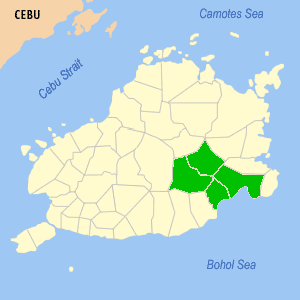
The Eskaya, less commonly known as the Visayan-Eskaya, is the collective name for the members of a cultural minority found in Bohol, Philippines, which is distinguished by its cultural heritage, particularly its literature, language, dress and religious observances. After the Eskaya first came to public attention in 1980, these cultural practices were the subject of intense speculation on the part of local journalists and amateur historians who made diverse claims about the ethnolinguistic status of the Eskaya people. The unique Eskayan language and writing system in particular has been a source of fascination and controversy. Some journalists argued that the Eskaya were historically displaced from the Middle East, while others suggested that the community was a cult speaking an invented language. According to Eskaya mythology, the language and script was created through divine inspiration by the ancestor Pinay who based it on the human body. Suppressed by the Spanish colonists, Pinay's language was said to have resurfaced under the leadership of Mariano Datahan, a veteran of Bohol's republican army. Although the historical existence of Pinay cannot be confirmed, more recent studies that combined linguistic analysis with oral history and genealogical research provide evidence that the Eskaya language was most likely created and disseminated within a generation by a charismatic individual. Today, the Eskaya are officially classified as an Indigenous Cultural Community under The Indigenous Peoples Rights Act of 1997. A number of reports have suggested that Eskaya linguistic and cultural education has been in steady decline since the mid-1980s, although promising revitalisation efforts have also been documented.

The Boholano people, also called Bol-anon, refers to the people who live in the island province of Bohol. They are part of the wider Visayan ethnolinguistic group, who constitute the largest Filipino ethnolinguistic group.

Eskayan is an artificial auxiliary language of the Eskaya people of Bohol, an island province of the Philippines. It is grammatically Boholano, the native language of Bohol, with a substituted lexicon. While Eskayan has no mother-tongue speakers, it is taught by volunteers in at least three cultural schools in the southeast interior of the province.

The Karay-a language is an Austronesian regional language in the Philippines spoken by the Karay-a people, mainly in Antique.
The Kabalian (Cabalian) language, Kinabalian, is spoken in the municipality of San Juan in the province of Southern Leyte in the Philippines. It is closely related to Waray-Waray.

Central Visayas is an administrative region in the Philippines, numerically designated as Region VII. It consists of four provinces: Cebu, Bohol, Negros Oriental, and Siquijor. The region also has three highly urbanized cities: Cebu City, Lapu-Lapu, and Mandaue.

Caycay is a Filipino crunchy layered cookie coated in syrup (latik) or honey and rolled in coarsely ground toasted peanuts. It originates from the islands of Bohol and Cebu and is a common specialty in the southern Visayas islands and Mindanao. The name comes from the verb kaykay which means "to dig up" in the Cebuano language, in reference to the step of coating the cookies in ground peanuts. Some versions coat the cookies in sesame seeds instead of peanuts.
Classical Cebuano, or Spanish-Era Cebuano, was a form of the Cebuano language spoken during the Spanish colonial era of the Philippines. It was the primary language spoken in Cebu, Bohol, and other parts of Visayas and Mindanao.
References
- ↑ "Lowlands-L Anniversary Celebration". www.lowlands-l.net.
- 1 2 Woff, John U. (2001). "Cebuano". In Garry, Jane; Rubino, Carl (eds.). Facts About the World's Languages: An Encyclopedia of the World's Major Languages, Past and Present. New York: H. W. Wilson.
- 1 2 Wolff, John U. (1972). A Dictionary of Cebuano Visayan (PDF). Cornell University. Archived from the original (PDF) on 2018-09-30.